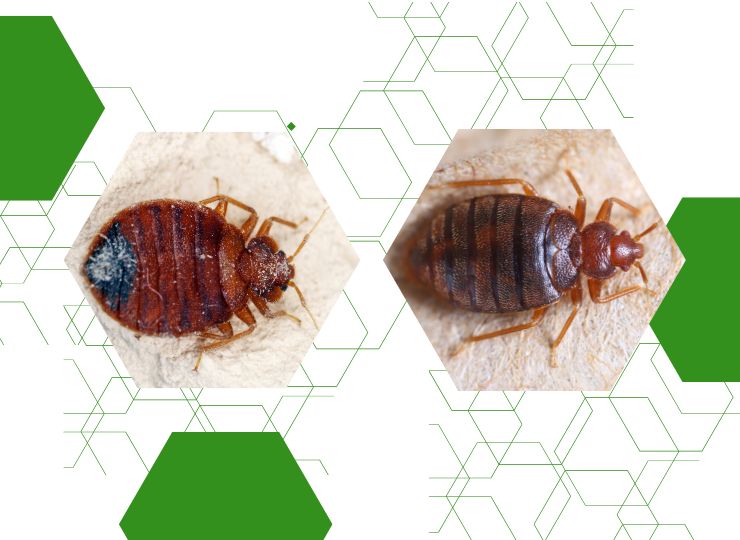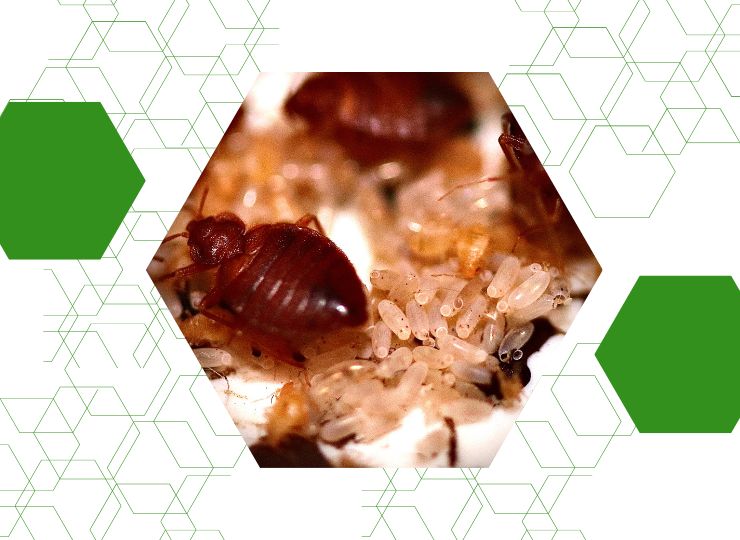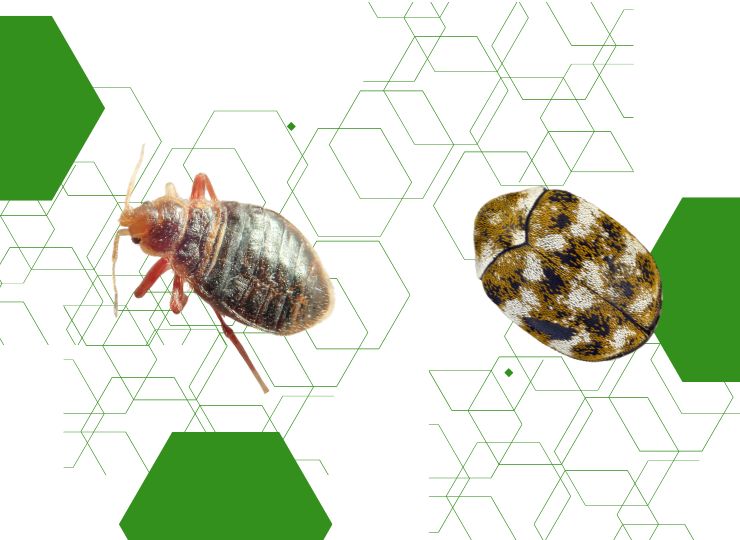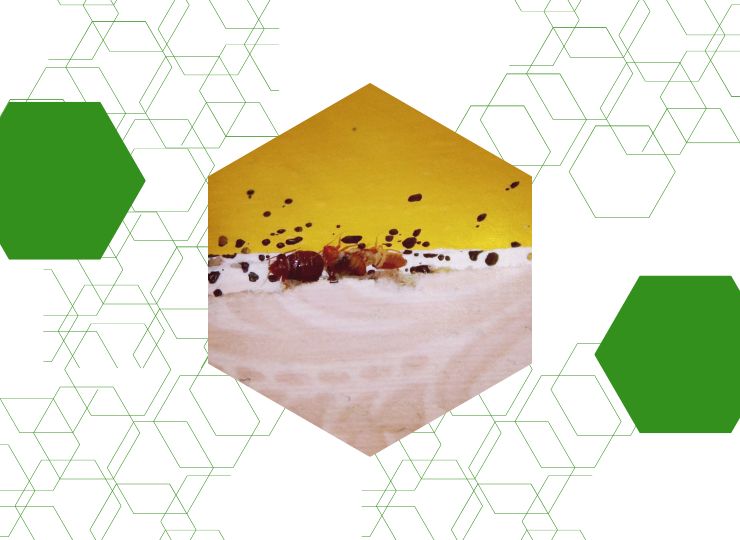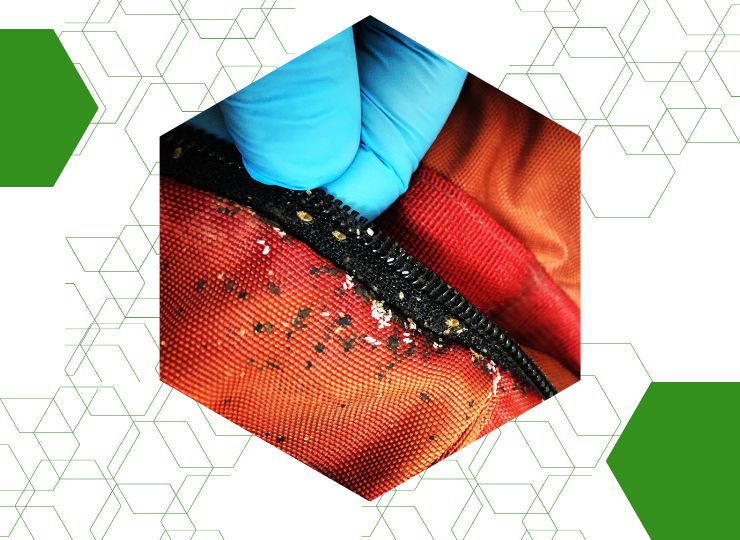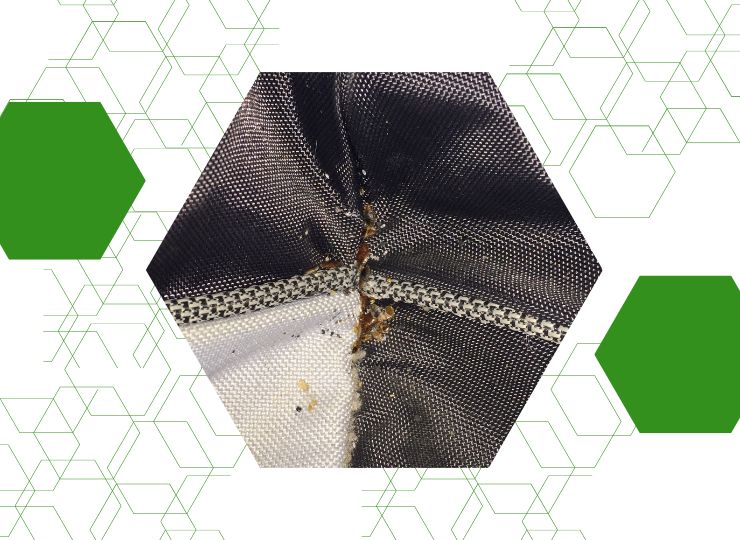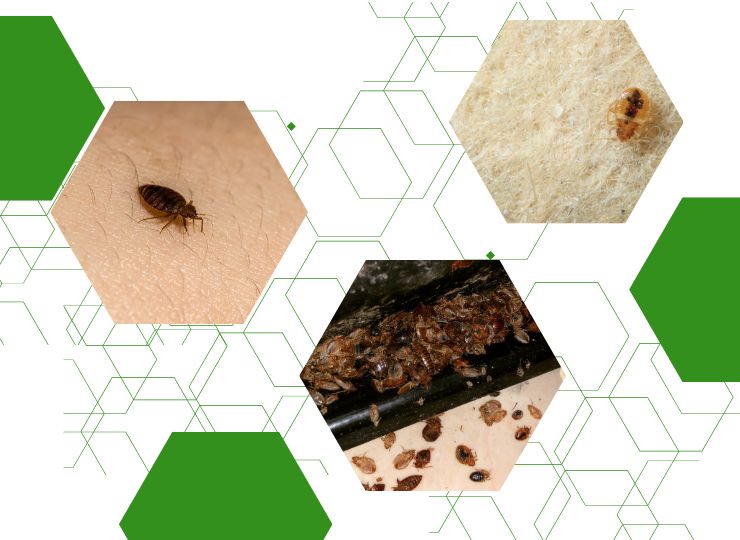What are Bed Bugs?
There’s a good chance that growing up you heard the rhyme “sleep tight, don’t let the bed bugs bite.” For most of us, this cutesy expression was just another way of saying “sweet dreams” or some other bedtime platitude. However, anyone who has lived with bed bugs knows that this sentiment is sincere and bed bugs are a nightmare to be avoided!
Whether you’ve just heard of these blood suckers and want to learn more, or you already have an infestation and are looking for relief – this article is for you. At Cramer Pest Control we are experts at dealing with bed bugs and are here to help you with your bed bug infestation!
What is a bed bug?
Unlike many pests like mosquitoes, cockroaches, fleas, flies, and ants, there are only two species of bed bug! Both of these parasitic insects belong to the genus Cimex and feed nocturnally on human blood.
Humans have been plagued by bed bugs for at least the last 3500 years – something we know from finding their desiccated remains amongst King Tut’s burial grounds! Today, these secretive pests are found everywhere on earth that humans dwell – from roadside motels to high end hotels, trailer parks to multi-million dollar Hollywood Hills homes.
What are the two species of bed bug?
There are just two species of bed bugs: Cimex lectularius and Cimex hemipterus.
C. lextularius, or the common bed bug, is found everywhere, while C. hemipterus is generally confined to more tropical regions.
What do bed bugs look like?
Despite being found everywhere – most people have never seen a bed bug as these creatures only come out at night to feed and hide deep within crevices during the day. However, it is important to know what bed bugs look like – just in case you should ever spot one!
Bed bugs are reddish-brown insects with 6 legs, and oval bodies. They do not fly or jump, but instead crawl quickly over most surfaces (including walls and ceilings!).
How big are bed bugs?
Adult bed bugs are 3/16th of an inch long – or about the size of an uncooked lentil bean and are roughly the shape of an apple seed. Not a big bean eater? Well, an adult bed bug is as long as three pennies stacked on top of one another are tall.
Juvenile bed bugs, or nymphs, start out as dust-sized eggs which are nearly impossible to see. As they grow, they will molt their skin and become successfully larger. The youngest nymphs are very hard to see, and are only a fraction of the size of adults. Older nymphs look like adults, but with lighter coloration.
What color are bed bugs?
Adult bed bugs are reddish-brown in color. You can think of their color as similar to that of dried blood… and for good reason, since their diet wholly consists of blood. Younger bed bugs are lighter in coloration, with more of a tan hue.
Bed bug droppings are dark reddish brown – and when made wet these droppings will exhibit a redder hue belying their blood origins.
What other bugs look like bed bugs?
Bed bugs look fairly distinctive – and behave differently than many other types of household insects. However, if you weren’t sure what a bed bug was, you could be forgiven for mistaking one for a cockroach or carpet beetle! Their general body shape and color are similar enough – although cockroaches are far larger and have wings which cover their abdomen.
Carpet beetles are more similar in size to bed bugs, but like cockroaches their abdomens are covered by wings.
Can bed bugs jump or fly?
No. Bed bugs do not have wings and are not able to jump. If you have itchy bites around your ankles and have seen little jumping insects – you’re probably dealing with fleas. Flying blood suckers are almost always mosquitoes or biting flies – and are never going to be bed bugs!
What do baby bed bugs look like?
Bed bugs start their lives as dust-sized eggs laid in clusters. These pearl-white eggs are nearly impossible to see with the naked eye.
Once bed bug eggs hatch into their juvenile form,they are a pale yellow color which will slowly darken as they age and consume more blood meals. The nymphs have the same basic body shape as their adult form, simply in a smaller form factor.
How do bed bugs get into my home?
Bed bugs are hitchhikers who love to travel. A common way that people get bed bug infestations is by visiting a space that is infested with them – and then unknowingly bringing some back home with them!
Adult bed bugs are nocturnal and emerge from their hiding places at night to feed. After having a meal, they seek out other sheltered spaces – and will happily hide themselves in suitcases.
If you are unlucky enough to have brought a few bed bugs back home with you, then they will begin to breed and your home will become infested.
What are the signs of a bed bug infestation?
Unlike many pests, it is relatively easy to have a bed bug infestation without having ever seen one in your home. Most often, people realize that there is a problem only after receiving numerous bites.
What do bed bug bites look like?
Because of their elusive nature, bed bugs typically are detected because of their bites! Within a day or so of being bitten, many people develop itchy welts at the site of the bite. These bites are often found in clusters or lines – and will be found on areas of exposed skin. The bite itself often is mistaken for a mosquito bite, as the bite looks and feels very similar to these more familiar nuisances.
Something important to note is that upwards of 30% of people have no allergic reaction to bed bug bites and this percentage seems to increase with age. This means that if one person in a couple is getting bitten and the other isn’t – it might just be that the other person isn’t showing signs!
How do I check for bed bugs?
Getting bitten by bed bugs is not the only way to recognize an infestation! In many cases you can spot an infestation in a hotel room or vacation home by carefully examining the beds before settling in for the night.
Check along the mattress seams for rust colored stains or small black dots that resemble a dot applied by a marker. The stains are caused by bed bugs which have been accidentally crushed and the dots are bed bug excrement.
In heavily infested areas you may be able to find the bugs themselves. Places to check include cracks and crevices in headboards, bed frames, box springs and baseboards, as well as in electrical outlets or behind loose wallpaper.
If you spot signs of bed bugs in your home it is important to act quickly before they have time to spread. Contact an experienced local exterminator and schedule an appointment.
Are bed bugs becoming more common?
Yes, bed bug populations are increasing rapidly around the world. Some estimates say that the global population is increasing by 100 to 500% per year, meaning that bed bug infestations are far more common today than in the past, and this trend is set to continue.
Do bed bugs spread disease?
There is no evidence to suggest that bed bugs can spread disease. While 40 different pathogenic bacteria have been found on and inside of wild bed bugs, there are no accounts of bed bugs spreading infections.
One theory is that bed bugs themselves have robust immune systems, and so the pathogens are disrupted or killed before they are able to be passed on to another person. Regardless of the mechanism – disease is the least of your worries when it comes to bed bug bites.
However, do keep in mind their itchy bites can develop secondary infections. These infections come from bacteria or viruses introduced from your environment and do not originate in the bed bug itself.
How do I get rid of bed bugs?
Bed bugs are a very challenging pest to eliminate and the process usually takes several weeks or months to complete. Do-it-yourself removal methods can work, but require patience and persistence.
Pre-treatment: Decluttering, isolation, and cleaning
Regardless of whether or not you choose a DIY or a professional approach to bed bug removal, there will be some steps you must take on your own:
Declutter
The first step is to declutter your living space. Clutter provides numerous hiding places for bed bugs, making it harder to treat the infestation effectively. Begin by sorting through your belongings and getting rid of unnecessary items. Newspapers, cardboard boxes, piles of clothing, and couches are notorious bed bug hideouts.
If you find heavily infested or difficult-to-clean items, it’s best to dispose of them properly. Mark furniture and other large items with “bed bugs” using spray paint to prevent others from picking them up.
Isolation
Generally bed bug infestations are quite contained – often limited to a single bedroom. Thoroughly inspect each room of your house and if you determine that there are rooms which are “clean” of bed bugs, do your best to keep them that way!
Do not move any untreated clothing, linens, or furniture from an infested room into a clean room.
Put your mattress and box-spring inside of bed-bug proof covers. While bed bugs can last a very long time without food, any trapped inside will eventually die. Plan on using the covers for at least a year.
This isolation tactic is a good idea for difficult-to-clean or heat-sensitive objects that you do not want to part with. Put infested items in a sealed plastic bag and wait at least one year.
Cleaning
Vacuum infested furniture and rooms very thoroughly. Take your time and be sure to go over every inch of carpet and use your vacuum’s crevice tool to get into nooks and crannies. This will not remove all bed bugs, but can make a sizable dent in their population and increase the efficacy of follow-up treatments.
The vacuum bag will need to be put in a sealed plastic trash bag and thrown away immediately afterwards. Thoroughly clean your vacuum, discarding or cleaning any removable filters.
All clothes, bed sheets, and linens should be washed in hot water and then dried on your dryer’s highest heat setting.
DIY bed bug treatment methods
Should you choose the DIY treatment route, be aware that the journey to a bed bug free home is a long one. With professional treatment it may take weeks to eliminate an infestation, but the EPA advises that DIY treatments can be a year-long process.
DIY Chemical Treatment for Bed Bugs
The most important thing to know about chemical treatment for bed bugs is that it is essential to only use EPA-approved pesticides and to follow the directions. Improper usage can encourage bed bugs to develop a resistance to treatments and can expose you or your family to dangerous toxins.
Be sure to only use insecticides which specifically state that they are effective for bed bugs and avoid the following home-remedy treatments:
- Rubbing alcohol
- Gasoline
- Pool or food-grade diatomaceous earth
- Propane
- Carbon dioxide
- Helium
DIY non-chemical treatment for bed bugs
While chemical treatments are best left to the pros, there are non-chemical treatment methods which can prove safe and effective – although you need to be prepared to repeat treatments many times over the course of several months.
Physical removal, heat, and desiccation are your three best tools against bed bugs.
Bed bug removal
Removal is the simplest, and only requires that you completely eliminate any clutter in the area and vacuum regularly. Be sure to seal contaminated vacuum bags in a plastic bag and then dispose of them promptly.
Note: It is impossible to vacuum up bed bug eggs as the eggs are cemented in place. Also, bed bugs preferred hiding spots are deep within crevices – making them difficult or impossible to remove with a vacuum. However, vacuuming will help you better monitor your bed bug infestation by removing dead bugs, feces, and discarded moltings.
Heat treatment for bed bugs
Bed bugs are sensitive to high temperatures, making heat a preferred method of eliminating them. Temperatures over 113F kill bed bugs – but it is important to note that the bug itself needs to be heated to this temperature. Because they hide in cracks and crevices, heat treatment often works best at higher temperatures which are held for longer amounts of time.
Steamers are the most common device used for treatment as the steam can reach deep into cracks and crevices. It is recommended to use low-pressure as high pressure steam can cause the bed bugs to flee. Go over all treatment areas slowly and methodically.
Keeping bed bugs out of your bed
Bed bugs, while a very annoying pest, can not fly or jump, and so we can protect ourselves from them by preventing them from getting onto our bed.
After cleaning your sheets (as described above) bagging your mattress/box spring in a bed bug proof cover, and heat treating your bed frame, you are ready to set up bed bug interceptor traps. There are commercial models available, or they can be made fairly cheaply and easily at home. These traps are placed under each of the feet of your bed frame, and prevent bed bugs from being able to climb into bed as you sleep. The traps should be monitored and replaced weekly.
Note: For these traps to work, your bed’s frame and headboard must be pulled away from the wall, and no sheets or blankets can be allowed to dangle onto the floor.
What professional bed bug control includes
Do-it-yourself bed bug treatment is a long process – certainly months, and possibly up to a year. If you aren’t interested in waging such a long war against these bloodsuckers, professional treatment options eliminate bed bugs much more quickly.
How professionals identify bed bug infestations:
Professionals begin with a thorough inspection to locate bed bug hiding spots. Bed bugs can hide in tiny crevices, electrical outlets, and behind baseboards, places the untrained eye may miss.
At Cramer Pest Control we have specially trained bed bug sniffing dogs which are able to detect them even when they are completely out of sight.
Whole-room heat treatments for bed bugs
It takes a lot of heat to kill a bed bug – and for most homeowners this means they’re limited to steam cleaners or dryers for linens and clothing. However, professional pest control technicians have high-powered space heaters which can raise the temperature of the room to a level which bed bugs cannot survive.
These heaters need to be used with care – and it is not recommended that homeowners attempt to DIY this particular solution.
Professional grade pest control agents
Bed bugs can develop resistance to insecticides and so the most readily available treatment options are also those least likely to work. Properly certified pest control technicians can get access to EPA-regulated pesticides which are more powerful and remain effective even in the face of resistance.
How many visits does it take a professional to eliminate a bed bug infestation?
Controlling bed bug infestations almost always requires multiple visits. If even a single pregnant female bed bug is left behind, or a single clutch of eggs is untreated, the infestation will return.
Generally the first follow-up visit will happen within 3 weeks, as this is enough time for eggs to hatch, but not enough time for the new hatchlings to reach maturity and lay eggs of their own.
Do I need to do anything for bed bug control if I hire a professional?
Yes. Even when you work with a professional you will still need to do your part. Your pest control company will let you know what that role entails, but typically it involves washing and drying laundry and linens, as well as general cleaning and decluttering.
Can you get a bed bug infestation from public transportation?
Technically, yes – although the likelihood is very low. In 2023 there were reports of bed bugs on public transportation in Paris and London. However, the local governments were quick to point out that no infestation was present and that their cleaning procedures were thorough and adequate.
Bed bugs are only active at night, and so even if there were bed bugs on public transportation, most daily commuters would not come into contact with them.
However, it does seem that bed bugs are becoming more common on public transportation and thus could be a greater risk in the future.
How do you avoid getting bed bugs?
Preventing a bed bug infestation is easier than dealing with one. By adopting a few simple habits, you can significantly reduce the risk of bringing these pests into your home.
When traveling, always inspect hotel rooms for signs of bed bugs. The first thing you do before unpacking should be to check mattress seams, headboards, and furniture crevices. If you see signs of bed bugs speak with the hotel management immediately and request another room. Even if you do not see any signs of bed bugs, keep your luggage elevated on racks and away from the bed or floor. This makes it less likely that you’ll bring any of these hitchhiking pests home with you. When you return home, immediately wash and dry your clothes on the hottest settings to kill any potential hitchhikers.
At home, regular cleaning and vacuuming of bedding, furniture, and carpets can help prevent early infestations from taking hold. Be cautious when purchasing second-hand furniture – inspect every piece thoroughly for bed bugs before bringing it inside.
Sleep Tight and Don’t Let the Bed Bugs Bite
Bed bugs are an increasingly common problem and are notoriously difficult to get rid of. Your best bet is prevention – take care when traveling and be sure to wash and dry your clothing promptly upon return. If you suspect a bed bug infestation, you should act fast before it has time to become serious.
Your best bet is to choose a licensed pest management company that has experience controlling bed bugs. You will still need to do a little legwork on your own – such as cleaning your linens and clothing and disposing of clutter – but your pest control company will take care of the hard work for you!
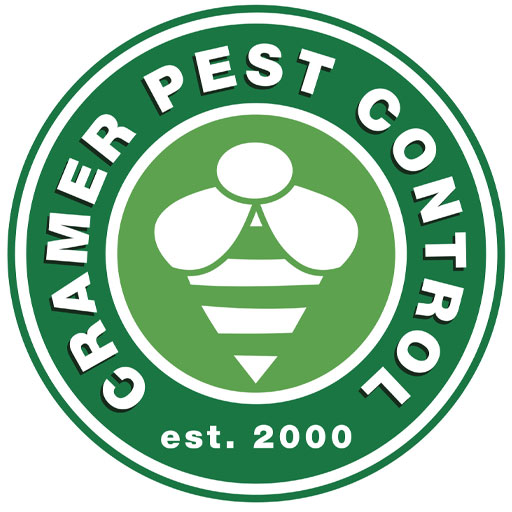
What are Bed Bugs in North Carolina and South Carolina?
Protecting North Carolina and South Carolina

